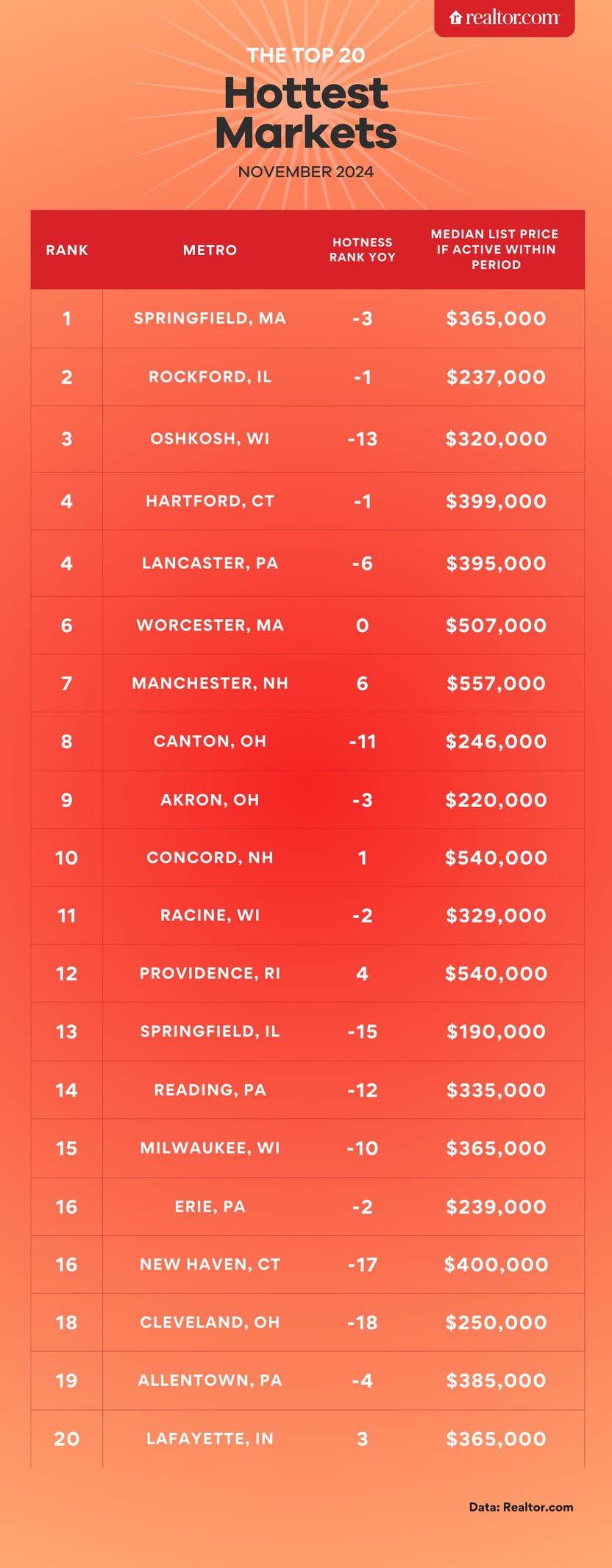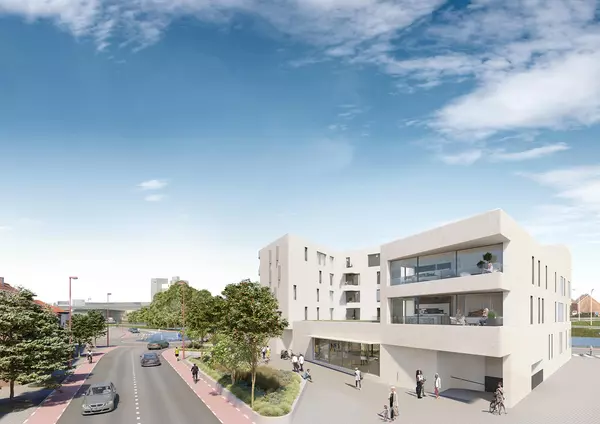Surprising Massachusetts City Hits No. 1 on the Hottest Housing Markets List—Yet Owes Its Rank to Another City

Realtor.com; Getty Images (5)
A surprising Massachusetts city has hit the Realtor.com® Hottest Housing Markets list for the first time in seven years.
Springfield has consistently ranked among the top 20 markets for over three years, which solidifies the Boston-adjacent metro’s status as a standout performer in hot markets dominated by the Northeast and Midwest.
“Springfield’s hotness means that high demand is met with low inventory as buyers claim available homes,” says Hannah Jones, Realtor.com senior economic research analyst, in her report.

DenisTangneyJr/Getty Images
Homes in Springfield attracted nearly three times the national average in views per listing and sold faster than in almost any other market in an average of 37 days. (Homes in the hottest markets were snapped up in an average of 40 days compared with 62 days nationally.)
The Boston area’s lasting appeal
For the past few years, almost all of the No. 1 hottest markets have one thing in common: proximity to Boston.
“One of the reasons that markets around Boston have done so well is the success of Boston itself,” explains Realtor.com Chief Economist Danielle Hale. “The region is an education hub, home to many top universities, and as a result, attracts workers in high-paying knowledge industries like technology and research.”
While Boston is 89 miles away, many buyers may have a flexible work schedule, enabling them to live just outside the large metro.
“With an abundance of high-skilled jobs, we also see more flexible work arrangements, either remote or hybrid positions, advertised in Boston-area job postings,” says Hale. “This likely benefits surrounding areas that are near to and much more affordable than Boston, as previous research has shown homebuyers pursue housing in lower-cost markets when they have workplace flexibility.”
In years past, Manchester, NH, located about an hour away from Boston, claimed the top spot an astounding 31 times, including last month. In November, the city fell to No. 7, proving its proximity to Beantown keeps it in the top 10.
The Northeast and Midwest continue to dominate
For the 14th consecutive month, every market on the Hottest Housing Markets list hailed from the Northeast or Midwest.
These regions claimed 11 and nine spots, respectively, highlighting their enduring appeal.
“The Northeast is relatively compact geographically, which contributes to more cross-metro employment and other economic influences,” says Hale.
One major economic factor is how much a home costs in these hot regions. While the nation’s median home price was $416,880 in November, 16 of the top markets have median home prices below that figure.
Key newcomers to the top 20 included Cleveland (No. 18) and Lafayette, IN (No. 20). Each saw high demand and relatively low prices of $250,000 and $365,000, respectively.
“This month’s list underscores the dominance of affordability-driven markets,” says Jones.
Meanwhile, Manchester continued its streak as a perennial favorite despite posting a 7% price increase.
Springfield, however, saw prices rise by 4.3% year over year, perhaps explaining part of its climb to No. 1.
Home prices climb in hot markets
While home price growth fell slightly nationally in November by 0.7% compared with last year, the hottest markets defied this trend.
Annual price growth across the top 20 climbed to 5%, up from 2.9% in October.
Lafayette led the pack with a stunning 30.4% price increase, followed by Rockford, IL (13.2 %), and Cleveland (+10.9%).
Despite housing stock growing 16.5% year over year in these markets, supply remains constrained. The scarcity of housing stock fuels competition and, therefore, price growth.
“Though inventory is improving annually in most of the hottest markets, there were an average 57% fewer homes for sale in November among these hottest markets compared to pre-pandemic, far outpacing the national decline of 21.5%,” Jones notes.
A look at the market temperature
While Springfield climbed up from last month, not every market maintained its momentum.
Rochester, NY, Boston, Norwich, CT, and Janesville, WI, all fell out of the top 20 in November.
“Looking instead at which metros have fallen the furthest over the last year reveals a list of mostly Southern markets that have fallen from popularity,” says Jones.
Indeed, Nashville, TN, and Tampa, FL, saw their rankings plummet by over 100 spots year over year as affordability concerns pushed buyers toward the Midwest and Northeast.
Among the 40 largest metros, New York City made the biggest splash, jumping 80 spots year over year to rank as the 170th hottest market in November.
Other climbers on the list included Minneapolis (48 spots) and Philadelphia (38 spots), further signaling a rebound in demand for larger metros.
Despite these gains, large markets overall cooled slightly, with an average decline of eight spots. Prices in these metros fell 1% year over year, driven by available housing stock and affordability headwinds.
Where will it be hot in 2025?
Looking ahead to the 2025 housing market, mortgage rates will likely shape its direction.
While rates climbed in late 2024, many experts predict they will fall in the coming months. The Realtor.com 2025 Housing Outlook anticipates mortgage rates to dip to 6%. If that happens, demand could rise nationwide, but don’t expect Springfield and other red-hot markets to lose their edge.
“Improving affordability could start to shake up buyer demand,” says Jones. “However, many less-hot markets across the country have seen a significant buildup in housing inventory, which can absorb an uptick in demand without much upward price pressure.”

Categories
Recent Posts










GET MORE INFORMATION

